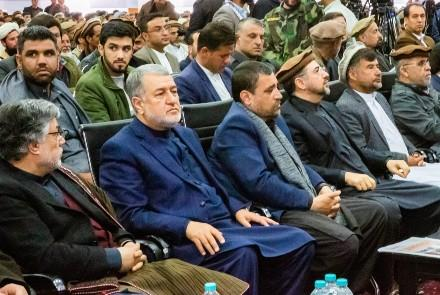Afghan Leaders Call for Inclusive Discussion on US Peace Plan

Prominent Afghan politicians on Wednesday urged that an assessment be made of the US-proposed draft peace plan and called on the Afghan government to not create barriers in the way of the peace process.
Mohammad Younus Qanooni, the former vice president of Afghanistan, said that the peace plan which was shared with them by US peace envoy Zalmay Khalilzad needs amendments, but shouldn’t be rejected out of hand.
He warned that rejecting the US-proposed peace plan without a careful consideration is an invitation to war.
“To blindly reject the peace plan is to invite war, a war that will not be in the interest of the Afghan people. Second, a blind acceptance of peace without deliberations and without an agreement on the fundamental principles will also lead Afghanistan toward another war,” said former Vice President Mohammad Younus Qanooni.
Other political leaders said that the president cannot represent the entire nation in the peace process.
The politicians spoke during a gathering to mark the 10th anniversary of the death of General Mawlana Saeedkheli, the former police chief of Kunduz.
The politicians said that all parties should be involved in the peace process.
“This opportunity shouldn’t be wasted for short-term gains and for a symbolic ceasefire, or for a group to exploit it for the continuation of its illegitimate grip on power,” said Salahuddin Rabbani, the head of Jamiat-e-Islami.
“The peace process in Afghanistan should have international guarantees, it should carry guarantees from the regional countries—there is also a need for national consensus for the peace process in our country,” said Ahmad Zia Massoud, a former vice president.
Proposed Draft for Afghan Peace
TOLOnews has seen a proposed draft plan for Afghan peace that was recently shared with political leaders and outlines a roadmap toward an end to the violence and a structure for a future government.
The guiding principles for Afghanistan’s future, the structure of a transitional government, and a political roadmap for a lasting ceasefire are the three significant elements of the draft.
The draft states that when the term of a proposed transitional government ends, the future leader of Afghanistan will be elected through a popular vote.
The second part of the draft states that Islam is the official religion of the country, all Afghan citizens will be provided security, and Afghanistan is the common home for all ethnic and religious groups.
In addition, the draft proposes a new constitution and says it will protect the rights of women and children.
The transitional peace government, according to the draft, will have three separate branches:
The executive administration, which will be headed by the head of state, with cabinet ministers as well as independent directorates from other areas.
The national parliament, which includes the parliament and the senate. Based on this draft, the Taliban representatives will be included in the national assembly, but the exact number of members is not clear.
The judiciary, which also includes the independent high council for Islamic jurisprudence and the commission for drafting a new constitution.
According to the draft, the high council of Islamic jurisprudence will have fifteen members, seven of whom will be Taliban members, the other seats will be filled by the government of the Islamic Republic, with one member appointed by the head of the government. The council is tasked with providing Islamic guidance in the social, cultural, and other contemporary sectors of the country.
According to the draft, a transitional “Peace Government of Afghanistan” shall be established as of the date of the agreement.
The draft says that the “Peace Government shall exist until it transfers power to a permanent Government following the adoption of a new constitution and national elections. This transfer of power shall occur no later than [xx] months from the date of this Agreement.”
